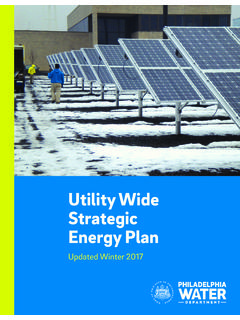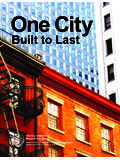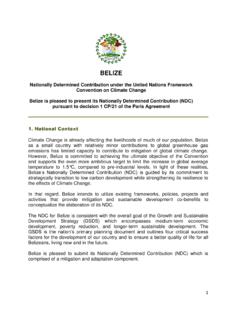Transcription of 41 Exemplar case study - Environment Design Guide
1 EDG 77 RE January 2013. ISSN 1442-5017. 41 Exemplar case study Russell Evans Abstract Having outgrown its old Melbourne headquarters, the Australian Institute of Architects decided to rebuild on its blue-chip piece of Melbourne CBD real estate. The brief to designers Lyons Architects was to conceive and construct a building that embodies the values of sustainable architecture in a modern multi-storey commercial office building. This note discusses the notion of the Total Carbon Metric, a quantitative tool used for the building's Design that measures carbon emissions brought about by embodied energy (materials), operational energy, transport and waste over a 30-year total lifecycle.
2 EDG 77 RE January 2013. 1. Introduction these options, the feasibility study concluded that the current site provided an excellent prime city location 41 Exemplar 41X for short will be the new which was popular and convenient for both staff and Melbourne home of the Victorian division of the members, and therefore the best option would be to Australian Institute of Architects (the Institute). rebuild on the site. Located at 41 Exhibition Street, Melbourne, the 21. Through a Design competition held in 2009, Lyons storey strata-title commercial office building is due and their consulting team (including AECOM) were for completion in late 2013.
3 Awarded the project. The Institute initiated the project through a Design competition which was won by Melbourne's Lyons Architects in conjunction with AECOM. The Institute's inspiring vision for the project is Building stats an Exemplar case study in sustainable Design 5 Star NABERS Energy Base Building and a new direction in Australian building Design . 5 Star Green Star In response to this vision, AECOM, the project's occupied floors: 21. integrated sustainability and building engineering services consultant, proposed a carbon-centred NLA: 5585m2. Design approach focussed not just on operational GFA: 8554m2. energy, but also encompassing the embodied energy office floor plate: 285m2 NLA.
4 Within the materials, waste and transport. This Institute staff: 72 people approach utilised AECOM's Total Carbon Metric (TCM). methodology. Subsequently, the TCM has been used as a key driver in the Design and construction of 41X, and will continue to underpin the management and operation of the new building to reduce the carbon In 2011, a contract for the construction of the new impact of 41X. building was agreed with Hickory, with the project scheduled to be completed in late 2013. One of the project's innovative and far reaching initiatives is a Sustainability Charter for all building Functional space types include basement back- tenants.
5 The Sustainability Charter binds tenants to of-house, ground floor retail and 21 levels of the sustainability agenda for the building to monitor commercial office space including Institute offices. and, where needed, change behaviours. On an annual The building is targeting a 5 Star NABERS (National basis, the measured operational carbon footprint of Australian Built Environment Rating System) Energy the building's tenants will be independently assessed. Base Building rating and 5 Star Green Star Office v3. Combined with the quantified embodied carbon of Design rating. the physical building, the operational carbon will be offset annually.
6 This case study describes how the project team has delivered the Institute's vision for 41X and steps Thermal performance through AECOM's TCM. It presents the quantity Building perimeter to internal zone ratio is of carbon generated by the building's embodied 65%, which led to a high performance building material emissions, operational energy, transport and envelope. The east/west facade U-value W/. waste. It then looks at how the TCM tool influenced m2K, SHGC. the building's Design and explores the role the TCM. had on the building's unique Sustainability Charter. The south facade U-value W/m2K, SHGC. HVAC strategy is a floor-by-floor variable volume The building low temperature system with demand control ventilation and 50% increase in outside air rate.
7 The inception of 41X dates back to 2006 when the Institute commissioned a detailed feasibility study Thermal plant comprises roof top air cooled for the site. The standard of the previous premises chiller, tenancy closed circuit heat rejection plant at 41 Exhibition Street was the lowest of any Institute and a forced draft boiler. accommodation in the country. It needed a complete refurbishment, rebuild, or sale and relocation to achieve an appropriate standard. Having reviewed all EDG 77 RE January 2013. 2. The concept The Institute embraced the proposed carbon-centred The Institute's Design competition brief called for 6.
8 Approach and included emissions reduction analysis Star Green Star Office v3 Design and As Built ratings. in the brief as a requirement to complement the During the competition phase, the Lyons/AECOM. revised target of a 5 Star Green Star Office v3 Design Design team explored opportunities to meet this rating, whilst maintaining the original 5 Star NABERS. requirement but the unusual physical parameters Energy Base Building rating target. of the redevelopment with its small site footprint made it extraordinarily difficult to achieve within the commercial parameters of the project. Total Carbon Metric To counter the challenges confronting the delivery The TCM is an analytical process to quantify the of a 6 Star Green Star building, the Design team environmental impact of a development.
9 The TCM. formulated an alternative environmental solution tool involves the collation of data from embodied with a more holistic approach to a building's carbon carbon metric calculations, AECOM-developed waste cycle. The Design team considered that a building, and transport models, and a dynamic 3D energy through its construction and operation, builds simulation model. up a balance sheet of CO2 that is displaced to the Environment . Carbon is embedded in the building's The TCM is not a Life Cycle Analysis (LCA) tool construction and then continually emitted through but rather a comparative analysis tool. It enables its operation.
10 The new approach comprehensively the assessment of a Design 's carbon objective in considers the quantity of carbon that a building conjunction with the functional project requirements generates, and then seeks to displace that carbon and financial constraints. Data from the tool through Design methods in the first instance and quantifies the opportunities for carbon mitigation then, if required, offsite displacement the Total and, thus, the potential impact of Design initiatives on Carbon Metric. a building's carbon footprint. EDG 77 RE January 2013. 3. The TCM quantifies data for four critical carbon Waste (operational) Generated through daily sectors: operations, waste is a significant aspect of the ongoing operational carbon emissions of the building.





